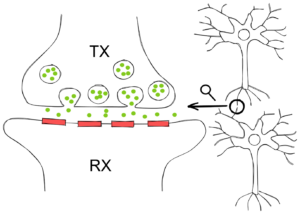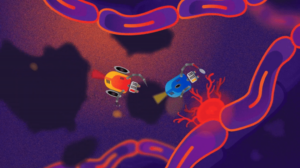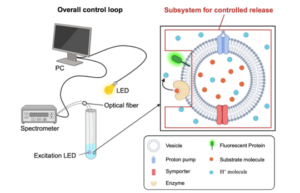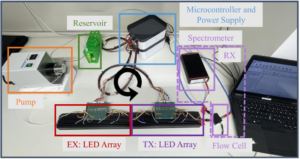Molecular and Biological Communication Systems

What are the means by which nanodevices may communicate?
Nanodevices may be conceived of as artificial cells created through the application of nanotechnology. However, for them to function effectively, they must be capable of communicating with one another.
The use of electromagnetic waves for in-body communication is challenging due to their tendency to be scattered. The inherent small size of nanodevices, coupled with the necessity for compact antennas, gives rise to high carrier frequencies and significant path losses.
One potential solution is the utilization of molecular communication, which represents a chemical form of communication. Information is conveyed by molecules, with the capacity to utilize varying concentrations of molecules for the transfer of data.
IDC @ 2 Minuten Wissen
Analysis of Natural Molecular Communication Systems

The analysis of natural molecular communication (MC) systems, including synaptic communication, hormone signaling, quorum sensing, and chemotaxis, provides valuable insights into how biological entities exchange information at the molecular level. Synaptic communication in neurons and hormone signaling in endocrine systems exemplify highly regulated, precise messaging mechanisms, while quorum sensing in bacteria and chemotaxis demonstrate collective and directional behavior based on molecular gradients. Understanding these natural communication processes can inspire the development of bio-inspired nanonetworks and molecular communication technologies for applications in medicine, synthetic biology, and environmental monitoring.
Communication System Design of Medical/In-body MC

Designing medical or in-body molecular communication (MC) systems involves creating biocompatible networks that transmit information using biochemical signals within the human body. These systems must take into account the unique constraints of the biological environment, such as signal molecular propagation via the blood flow. Applications for in-body MC include targeted drug delivery, continuous health monitoring, and the development of biosensors to diagnose and treat disease at the molecular level.
Communication System Design of Non-medical MC

The design of non-medical molecular communication (MC) systems focuses on the use of chemical signals for information transfer in environments such as industrial sensing, environmental monitoring, and nanonetworks. These systems must overcome challenges such as signal propagation in unpredictable media, interference from environmental factors, and the need for robust and scalable communication protocols. Non-medical MC can be applied in areas such as pollution detection, chemical process control, e.g., in a small-scale bioreactor, and smart agriculture, where traditional electromagnetic communication is impractical or inefficient.
MC Experiments: Testbeds at FAU

Molecular communication experiments, although simple in nature, are essential for validating theoretical models and assessing their feasibility in practical applications. These experiments help to identify discrepancies between theory and real-world behavior, providing insights into how to refine and improve communication models. Ultimately, this iterative process is critical for advancing molecular communication toward more complex in vivo experiments, where systems can be tested in living organisms for medical and biological applications. The testbeds were developed in collaboration with FAU partners, including researchers from the Chair of Bioprocess Engineering, the Chair of Technical Electronics and the Chair of Microbiology.